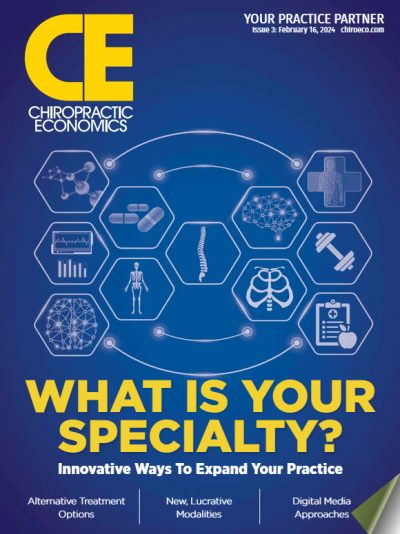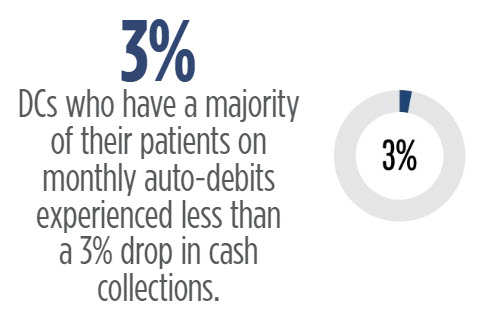ELEVATING CHIROPRACTIC SUCCESS IN TODAY’S LANDSCAPE
Posted on February 16, 2024 by Miles Bodzin, DC

Intelligent strategies for a resilient practice.
This article was originally featured in Chiropractic Economics Issue 3: Feb. 16, 2024
Readers of this article will gain valuable insights into creating success in today’s landscape by implementing intelligent strategies for a resilient practice. The article emphasizes the importance of pandemic-proofing your practice, focusing on patient retention, and revising payment collections for long-term success. It even shares data gathered during the global shutdown of March 2020, highlighting the significant impact of payment collection methods on practice stability.
The year of 2020 taught us many things, but one of the most important lessons we learned is, you must pandemic-proof your practice! From implementing safety protocols to exploring telehealth options, the key to protecting your practice and livelihood lies in resilience and strategic planning.
In my opinion, patient retention has never been more important if you really want to not only succeed and protect yourself from downturns, but I think we can all agree that patients get better clinical outcomes when they stick to care.
Revising payment collections has proven to be a game-changer for chiropractic practices. Automating monthly payments has emerged as a beacon of stability in uncertain times. In fact, we’ve taught for many years now that your PVA can be predicted on how you collect your fees. The message may evolve for today’s conversation and that the survival of your practice is dependent upon how you collect your fees.
Payment collection methods and the effects on your PVA:
| Business Model | PVA |
| Pay-per-Visit | 12 |
| Block of Visits | 24-36 |
| Pre-Pay Plans | 50-75 |
| Monthly Auto-Debits | 150+ |
As illustrated in the table above, the retention of a practice is generally well-predicted by the business model they use to collect their fees. The higher the retention rate, the healthier the practice. Some offices manage to get by with lower PVA, until a time of great stress, like a pandemic, happens.
In times of stress and economic uncertainty, these numbers get accentuated.
In the global shutdown of March 2020, we had the benefit of being able to gather data from thousands of offices. We were able to get a perspective of what was going on in the chiropractic industry.
What the Data Tells Us:
Our data showed us a significant difference between those doctors who had strategies in place designed to increase patient retention and those who did not. The doctors who were having patients pay-per-visit saw a 50% drop in cash collections. Compare that to the doctors who have a majority of their patients on monthly auto-debits, a key strategy for increasing patient retention, who experienced less than a 3% drop in cash collections. That’s a HUGE difference.

Which would you prefer? A 50% decrease or a 3% decrease? Having automated, recurring payments gives you financial stability in practice and fortifies your ability to keep the doors of your office open. But it’t not just recurring payments that gives this. It’s focusing on creating a high retention rate from the start.
What’s the strategy for achieving this?
Now that we know that we need to focus on patient retention, or what I like to call, patient loyalty, the strategy for achieving this is quite simple. Focus on a successful patient journey for each and every patient you see. The Patient JourneyTM is the process a patient goes through from the moment they call your practice through the eventual transition from initial care plan to lifetime wellness care patient.
And there are eleven unique steps to a successful patient journey. Think of this as the game plan that you and your team use to take the patient through to turning them into a loyal patient in your practice.
What makes up a successful patient journey?
So if we want to create a successful patient journey, you may be asking, how do we do that? You may be thinking, I already educate my patients and I’m doing all the things I’ve been taught to share the message of chiropractic. What else is there?
I’ve identified four pillars that go into making a successful patient journey.
The 4 F’s of Patient Retention are:
- Feedback that’s intuitive demonstrates the need for care and tracks progress throughout care.
- Forecasting Care ensures a clear path to wellness and doesn’t leave the patient confused about the game plan for treatment.
- Frictionless Payments take the financial discussions out of the equation and removes the thought of money.
- Frequent Contact that allows for automated education and marketing.
Let’s talk about the first F: Feedback. Just how intuitive is your Feedback? Do your patients understand the need for care and the progress that they’re making? Do they realize that improvements will still be made even if they’re out of pain? These questions are fundamental to think about. If a patient doesn’t understand how they’re doing or why they’re still seeing you, they’ll drop out of care. This is detrimental to your retention.
Think about this: Have you had a patient come to you that’s been to another chiropractor before? Did you ever ask the patient, “Why are you coming to me now? Why aren’t you currently seeing your previous chiropractor?” If you’ve asked this, you’ve probably heard the patient say something like, “I didn’t know how I was doing over there” or, “I felt like they just wanted me to keep going back, but I didn’t know why.”
The underlying cause of why that patient chose not to return was because the previous doctor failed to communicate the patient’s progress effectively. You can stop this from happening by providing Feedback that your patient understands.
Moving on to the next F, Forecasting Care. Do you forecast care for your patients, outlining their treatment plans with all of the recommendations that you know they’ll need rather than verbally telling them? Now think about your financial options for your patients. Do you have any? These go hand-in-hand and are so important for retention!
It would be best if you made it convenient for your patients to pay and understand their financial obligation to the office with a professional care plan with your recommendations included. This simple step can reduce those awkward financial conversations that no one wants to have, drastically improving your conversion to wellness care.
By recommending a plan initially and automating payments versus having them pay every time, patients will say yes, stay under care even when their insurance is exhausted, and they’ll transition to wellness care. By spreading the cost over manageable monthly installments, patients are more likely to commit to long-term care plans, resulting in better overall health outcomes.
For the third F, we’re going to talk about Frictionless Payments. Payments must also be a frictionless experience for your patient and your team! Ask yourself, “How often are patients stopping to pay at the front desk? Could I make this more efficient and automated for everyone involved?”
The #1 reason patients drop out of care is the repeated thought of money, which directly affects retention. If you can take the focus off the patient’s payments and onto their care instead, you will increase your PVA, retention, and profits.
Automating all payments in practice will save time, headaches, and frustration from manually entering billing information for all parties involved. If you could save upwards of 40+ hours a month by simply having billing automated, wouldn’t you do that?
However, not all payment systems are equal. It’s vital to ensure that you comply with your financial policies.
The last step to increase retention is Frequent Contact. How are you currently educating your patients? Are you flooding them with information on the first couple of visits? Or have you embraced a more practical approach to small bits of information shared over an extended period? It’s essential to have a constant connection with your patients to educate them frequently about the benefits of chiropractic.
During the pandemic in particular, frequent contact was of the utmost importance. Letting your patients know the importance of your care, the safety measures you were taking, the fact that you remain open to them… etc.
The uncertainty brought about by the pandemic made financial planning a daunting task for both practitioners and patients. Automated monthly payments ensure a steady and predictable cash flow. This stability is not only beneficial for the practitioners but also fosters a sense of trust and reliability with patients, as they can be assured the cost of their care is set at a rate which fits their budget.
If they were paying per visit, they are much less likely to come in during a stressful financial time. If they were struggling and asked to skip care for a month, it was a much easier conversation vs them not having any future payments scheduled and potentially disappearing as a patient.
Embracing these principles is a testament to a practice’s commitment to staying current with technological advancements. This not only enhances the overall patient experience, but also positions the practice as forward-thinking and adaptable – essential qualities in the ever-changing landscape of healthcare.
As the world navigates the challenges presented by the ongoing aftermath of the pandemic, chiropractors have a unique opportunity to make their practices resilient by reevaluating traditional payment collection methods. The data speaks for itself – practices that have embraced monthly automated payments have not only seen a reduction in financial volatility but have also laid a strong foundation for patient retention. By fostering a sense of stability, financial flexibility, and leveraging technology, chiropractors can not only survive, but THRIVE, in the new normal of healthcare delivery. So, let’s make the adjustment to automated monthly payments – your practice and your patients will thank you for it!

